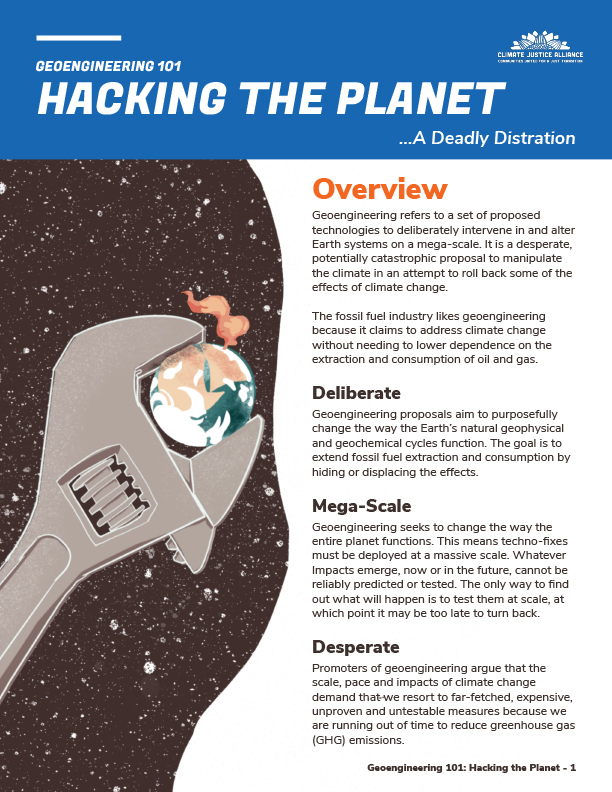Geoengineering 101
Hacking the Planet
Geoengineering is incompatible with climate justice…
In this section, we look at false solutions that encourage the idea that Earth-altering technology can be used to reverse climate change. This idea is promoted by groups of entrepreneurial scientists, a small number of funders, and the fossil fuel industry. It is generally referred to as Geoengineering.
One characteristic that is common to the geoengineering approach is the belief that we can use technology to reverse or detain climate change without having to cut carbon emissions by eliminating fossil fuel use. Geoengineering is a dangerous distraction. It does not address the root causes of the climate crisis–the drive for unlimited economic growth, and the greenhouse gas emissions that result from these activities.
CJA convenes the North America Geoengineering Working Group, which meets regularly by zoom to develop strategy and analysis around geoengineering techno-fixes. For information, contact: [email protected]
Geoengineering 101 Fact Sheets
CJA has created this series of fact sheets on Geoengineering under the title Geoengineering 101: Hacking the Planet, Carbon Capture and Storage, and Solar Radiation Management. These fact sheets cover the basic information on geoengineering.
Geoengineering Experiments
Hacking the planet to alter its atmosphere is no longer science fiction. Several dangerous geoengineering experiments are already underway, with potentially dire consequences for the earth.
Ocean Iron Fertilization1
In April of 2017, the international company Oceaneos Environmental Solutions divulgó announced its plan to carry out an iron fertilization experiment off the coast of Chile. Describing the process as “ocean seeding,” the company claims the introduction of iron dust would increase phytoplankton biomass, which would cause an increase in the commercially fished Chilean jack mackerel (Trachurus murphyi). As a climate bonus, CO2 would be buried in the ocean floor or remain for extended periods of time in deep water. Chileans critical of the project insist that the risk is simply not worth it and that many marine species would die. In 2012, the same company, operating under a different name, conducted a similar experiment off the coast of British Columbia, Canada, which was declared illegal by Canadian authorities.The experiment took place in the territory of the Indigenous Haida Nation in collaboration with a local company that wanted to tap into the carbon market. Haida leadership denounced the experiment for tampering with nature. Ocean interventions of this type violate both the London Protocol and the Convention on Biodiversity2.
1 https://www.etcgroup.org/content/geoengineering-threatens-oceans
2 FundacionTerram and Millennium Institute for Oceanography, Marine Geoengineering: A Great Risk for Chile, 2020, pp 4.

Artwork by Heather Thiry

Artwork by Heather Thiry
Cloud Brightening
In May 2020, a small group of Australian geoengineers3 carried out a risky geoengineering technique – brightening clouds to reflect solar energy back into space – and presented it as a plan to save the Great Barrier Reef. Led by researchers from Southern Cross University in New South Wales, the goal of the experiment was to lower local temperatures and slow the bleaching of the coral reefs. The experiment was funded by governmental sources, and more trials have been scheduled,4 also with public funding. The experiment contravenes the UN Convention on Biodiversity, which in 2010, established a moratorium on geoengineering activities until “a global, transparent and effective control and regulatory mechanisms… in accordance with the precautionary approach can be put in place.”5
3 Scientists trial cloud brightening equipment to shade and cool Great Barrier Reef, The Guardian, April 17, 2020.
4 Scientists trial world first ‘cloud brightening’ technique to protect the reef, Sidney Institute of Marine Science, April 16, 2020.
5 ETC Group, The Geoengineering Moratorium Under the UN Convention on Biological Diversity, November 10, 2010.
SCoPEx
The Stratospheric Controlled Perturbation Experiment (SCoPEx) is a stratospheric aerosol injection project that would spray water, finely-ground chalk, and sulfur particles from a high-altitude balloon into the upper atmosphere to produce a haze aimed at blocking the sun. Backed by Harvard scientists and money from several foundations, if SCoPEx is allowed to proceed, it would have the political effect of legitimizing geoengineering. In 2010, the UN Convention on Biodiversity (CBD) passed a moratorium that covers SRM experiments like SCoPEx. However, the U.S. is not a party to the CBD.

Artwork by Heather Thiry

Artwork by Heather Thiry
Ice911
The proposed Ice911 Project wants to experiment on Inupiaq and Gwich’n territories in the Arctic region by polluting the ice and oceans with tiny glass beads. The claim is that covering arctic sea ice with very large volumes of micro-glass beads might slow summer melting of Arctic ice. There are many unanswered questions about the impacts of this speculative technology on individual and community health, wildlife, the environment, and subsistence food ways, let alone reliable evidence that it would work. Ice911 is a Silicon Valley-based non-profit company led by engineers from the technology and oil industries. This project would make large-scale changes to the metabolism of the Earth. Rapid changes to the pattern of ice flows could impact animal migration as well as local weather patterns. Instead of protecting indigenous sovereignty, cutting greenhouse gas pollution, or lifting up traditional indigenous knowledge of how to live in right relationship with Mother Earth, this project proposes massive industrial interventions with no way of finding out what the impacts will be until it is too late.




